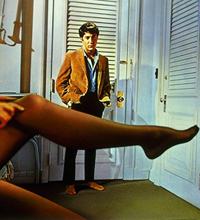

USA film school
1967
color 105 min.
Director: Mike Nichols
CAV: out-of-print collectible
2 discs, catalog # CC1115L
CLV: $49.95 - available
1 disc, catalog # CC1168L

Occasionally in the arts,
a work manages to speak to its contemporaries in a powerful and timely way that
seems to capture the essence of its era. The usual fate of such works is that
they become historical artifacts, of interest only to historians and
sociologists. A few works, however, manage to continue to speak across time,
renewing their hold on each generation because of their richness, complexity, and
treatment of universal concerns and experiences.This ability to transcend
different eras is what makes a work a classic. In American film history, one such
work is The Graduate, originally released in 1967.
In the more than two
decades since it first became a box-office phenomenon, The Graduate's
reputation as one of the great American comedies has grown and deepened. Its
treatment of a young man's initiation into the mysteries of sex at the hands of
an older married woman has become a model for this common fantasy. Even more
important is its sympathetic probing of the angst felt by so many
college-educated American youths.
The Graduate is what Hollywood in
later years would call a "high concept movie," that is, one that takes a basic
story and gives it a memorable twist. In this case, the
boy-meets-girl/boy-wins-girl/boy-loses-girl/boy-wins-girl structure is given new
life by the fact that the reason boy-loses-girl is that he's been sleeping with
her mother! This startling concept is what made the film seem scandalous at the
time. What is sometimes obscured is the fact that, long after people ceased to be
shocked by this twist, the film continued to attract new audiences. This is
because the film is, at its core, an otherwise-traditional story dealing with
desire that is first thwarted and then fulfilled through true love.
The
Graduate is a classic demonstration of filmmaking as a collaborative process.
Produced by the always-innovative Lawrence Turman for the always-daring Joe
Levine, the person who drew all of the film's elements together was, of course,
its director, Mike Nichols. After achieving fame as a standup comedian with
Elaine May, Nichols had become a celebrated Broadway director of comedy, but had
made only one film, Who's Afraid of Virginia Woolf?, which had not done
much to prove that he had any particular aptitude for the medium. With The
Graduate, however, Nichols proved that he had thoroughly mastered cinematic
technique.
There is, for example, the startling montage of the affair between
Benjamin Braddock, the film's protagonist, and the wife of his father's best
friend. Cutting back and forth between hotel bedrooms and his parents' swimming
pool, it ends with the young man diving into the pool and, in a perfectly-matched
cut, landing on top of his mistress in her bed, at which point we hear the voice
of his father ask, "Ben, what are you doing?" Justly lauded by critics and
historians, the scene was the result of careful collaboration between Nichols and
Sam O'Steen, one of Hollywood's foremost film editors.
Although often
neglected in discussion of the film, Charles Webb's novel, The Graduate,
was already very close to being a screenplay, and much of the dialogue in the
film was taken intact from the book. Buck Henry and Calder Willingham faithfully
made the transition from the novel, making significant contributions of their own
to the story's structure and characterization.
The cinematography of Robert
Surtees is immensely complicated, masterfully using special lenses such as the
zoom to capture the feelings of alienation, desire, and despair that are at the
heart of its central character. Even the contributions of collaborators usually
ignored by critics and audiences turn out to be crucial to the success of The
Graduate. The production design by Richard Sylbert and the production
supervision by George Justin, and even the costumes by Patricia Zipprodt, are
tightly integrated into the overall effect of the film.
The two things
everyone probably remembers most about The Graduate are the performance by
Dustin Hoffman and the songs by Simon and Garfunkel. The portrayal of the film's
title character was Hoffman's first major screen role. The New York Times
immediately declared him "an amazing new star," and the accolades were repeated
by countless reviews. Anne Bancroft, who had won Tony and Academy Awards for her
"good woman" roles, created in the film one of the all-time screen villainesses,
the bitchy but seductive Mrs. Robinson. Finally, Katherine Ross, who doesn't make
her entrance until one hour into the movie (as Mrs. Robinson's daughter, with
whom Benjamin falls in love) achieves a level of performance that has seldom been
equaled in an ingenue.
Simon and Garfunkel songs make the musical score of
The Graduate one of the most haunting and popular since Casablanca. There
are only four songs, yet they perfectly evoke the protagonist's dilemma, and, for
long stretches of the film, they make dialogue totally unnecessary because they
express more emotion than many pages of dialogue could possibly have
done.
Comedies are notoriously undervalued by the motion picture industry when
it comes time to give Academy Awards. The fact that the film received seven
nominations and that Nichols, still a relative newcomer, received the "Best
Director" award demonstrate that even the usually-serious Academy recognized that
The Graduate was a remarkable achievement deserving of special
recognition.
-- HOWARD SUBER
Credits
Producer: Lawrence
Turman
Director: Mike Nichols
Screenplay: Buck Henry, Calder
Willingham
Based on the novel by: Charles Webb
Director of Photography:
Robert Surtees, A.S.C.
Production Designer: Richard Sylbert
Film Editor:
Sam O'Steen
Production Supervision: George Justin
Sound: Jack
Solomon
Songs: Paul Simon
Sung by: Simon and Garfunkel
Additional Music:
Dave Grusin
Costumes: Patricia Zipprodt
Transfer
This
edition of The Graduate was transferred from a 35mm print made from the
original negative. After viewing available negatives, we decided that this print
would yield a superior picture quality on video. The sound was taken from the
original magnetic soundtrack masters.






